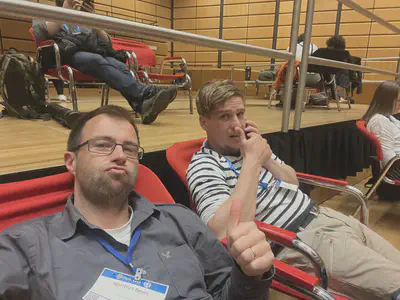Isodrones' double premiere at EGU 2023 - first keynote lecture and first UAV-Isotope synergy presented
….and thousands of weirdos running through a gigantic building.

I haven’t been to conferences for a while, but this year it was about time. The EGU is the biggest conference across geosciences - thousands of mad scientists talking nerdy stuff for one week. It’s a must for any researcher to experience this once (or it’s American equivalent, the AGU, which is even bigger!). The first time you go there, you end up spending days on puzzling together a program, running from room to room to see the best talks of multiple sessions, and eventually end up being completely saturated and exhausted by Wednesday ;) With a bit more experience, you pick the gems and use the other time for networking and catching up with friends, colleagues and potential future collaborators. You still end up being exhausted in the end ;)
I must say that I don’t love the EGU and I have an ambivalent relationship with it. For me, it is THE manifestation of capitalism in science. There were also great Especially this year, I had the feeling that many unready pieces of research were showcased, and that unfortunately quantity over quality is a principle that (too) many are following. On the other hand, it is a very valuable experience and, especially in early PhD stages, really opens up the mind. It is also important to stand in front of a crowd and explain your research to others, get feedback, and handle criticism.
Anyways, I decide to go myself this year and do not regret it. First off, I love Vienna and especially Hundertwasser. I wish his ideas and principles of bringing nature and colors back to cities would be acknowledged by current architectural planning. Then, I was invited to give a keynote lecture - for the first time in my life. I feel very honored to be chosen for this, and I decide to speak about something we - amongst others - are developing since 2018. The methodological part has become much easier, and studies are popping out where researchers show that we really do get great, continuous water isotope data using in situ methods in trees and soils. I am also super happy for the great feedback on this particular talk. Thanks ;)
Here’s the download link for the presentation: “EGU_Keynote:Why in situ isotope measurements need to become a standard in forest hydrological research”

My second talk was something else. I presented a piece of research I have been working on for a while now. We basically found a great spatial variability of soil water isotopes at our dry forest study site in Costa Rica, which - in the dry season - seems to be related with canopy parameters. We used UAV (drones) to derive these vegetation indices spatially and correlated them to the isotope values for ten soil water isotope depth profiles across the site. We found strong correlations for all depths between certain vegetation indices and the soil parameters (water content and isotope values). Based on this, we interpolated the soil water isotope values for the whole study site with the use of this UAV-derived data. Here’s the download link for the presentation: “EGU2023:VEGETATION CONTROLS SPATIAL PATTERNS OF SOIL WATER ISOTOPES IN A TROPICAL DRY FOREST AND UAV’S CAN HELP TO PREDICT THEM”

Wrapping this up, I do not regret going, and I had a lot of fun with colleagues and friends, as you can see in the pics down below!
Take care, mahalo, Mati

